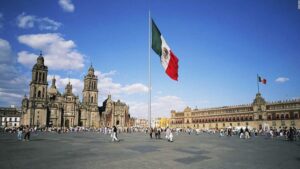
The safety of travel to Mexico can depend on various factors, such as the destination, purpose of travel, and current events in the country. While some parts of Mexico may be more dangerous than others, many areas are safe for travelers.
The U.S. Department of State issues travel advisories for Mexico, and you can check the current level of advisory for the specific region you plan to visit. Generally speaking, popular tourist destinations like Cancun, Playa del Carmen, and Los Cabos are considered safe for travelers.
It is always advisable to exercise caution, especially in crowded areas, tourist spots, and public transportation. You should also follow basic safety measures like avoiding displaying expensive items, keeping your belongings close to you, and not traveling alone in isolated areas.
As with any international travel, it is recommended to check with your country’s embassy or consulate in Mexico to stay updated on any travel restrictions or advisories.
Overall, Mexico can be a safe and enjoyable travel destination if you take appropriate precautions and stay informed about the current situation.
Where to Travel to in Mexico
Mexico is a vast and diverse country with many amazing destinations to visit. Some popular places to consider for your travels to Mexico include:
Cancun: Known for its beautiful beaches and vibrant nightlife, Cancun is a popular destination for those looking for a mix of relaxation and excitement.
Cancun is a city located on the northeastern coast of the Yucatan Peninsula in the state of Quintana Roo, Mexico. It is known for its beautiful beaches, crystal-clear waters, and luxurious resorts, making it a popular destination for tourists from around the world.
Cancun was originally a small fishing village, but in the 1970s the Mexican government recognized its potential for tourism and began to develop the area. Today, it is one of the top tourist destinations in Mexico and the Caribbean, with a wide range of activities and attractions to suit every interest.
Some of the most popular activities in Cancun include swimming, sunbathing, snorkeling, scuba diving, and other water sports. The city is also home to a number of archaeological sites and nature reserves, such as the Mayan ruins of Tulum and the Sian Ka’an Biosphere Reserve.
Cancun’s vibrant nightlife is another draw for visitors, with many bars, nightclubs, and restaurants offering a variety of entertainment options. The city is also known for its shopping, from local markets to luxury boutiques.
Overall, Cancun is a beautiful and exciting destination that offers something for everyone, whether you’re looking to relax on the beach or explore the area’s cultural and natural attractions.
Mexico City: The capital city of Mexico is full of history, culture, and delicious food. Visit museums, explore ancient ruins, or simply stroll around the city’s many neighborhoods.
Mexico City is the capital city of Mexico and the largest city in North America, with a population of over 8 million people. It is located in the Valley of Mexico, at an altitude of 2,240 meters (7,350 feet) above sea level.
The city has a rich history and cultural heritage, with many museums, art galleries, and historic landmarks. A tip I got from a Chimney Sweeps Maine business owner who just returned from Mexico City is some of the most popular tourist attractions in Mexico City include the National Museum of Anthropology, the Palace of Fine Arts, the Zocalo (the city’s main square), and the ancient ruins of Teotihuacan.
Mexico City is also known for its cuisine, which includes traditional dishes such as tacos, tamales, and chilaquiles, as well as more modern and innovative cuisine. The city is famous for its street food culture, with many food vendors selling their goods on street corners and in markets throughout the city.
Mexico City has a vibrant arts and culture scene, with many festivals, concerts, and events taking place throughout the year. The city is also home to several universities and research institutions, and is a hub for business, finance, and commerce in Mexico and the wider region. However, the city also faces challenges related to pollution, traffic congestion, and social inequality.
Puerto Vallarta: Located on the Pacific coast, Puerto Vallarta offers stunning beaches, excellent restaurants, and a vibrant arts scene. Puerto Vallarta is a resort town located on the Pacific coast of Mexico, in the state of Jalisco. It is known for its beautiful beaches, scenic mountains, and charming cobblestone streets. Puerto Vallarta is a popular tourist destination and offers a wide range of activities and attractions for visitors.
Tulum: This small town on the Caribbean coast is famous for its beautiful beaches and well-preserved Mayan ruins.
Tulum is a town located on the east coast of the Yucatan Peninsula in Mexico. It is known for its stunning beaches, crystal-clear waters, and the well-preserved Mayan ruins of Tulum.
Tulum is a popular tourist destination and is known for its eco-tourism and wellness offerings, such as yoga retreats, meditation centers, and healthy food options. The town has a bohemian vibe and is home to many boutique hotels, restaurants, and shops.
The Tulum Ruins are a must-visit attraction for visitors to the area. These ancient Mayan ruins sit atop a cliff overlooking the Caribbean Sea and provide a fascinating glimpse into the region’s rich history. Other nearby attractions include the Sian Ka’an Biosphere Reserve, the Gran Cenote, and the Coba Ruins.
Tulum’s beaches are some of the most beautiful in the world, with soft white sand and turquoise water. Visitors can enjoy swimming, snorkeling, scuba diving, and other water activities. The beach is also lined with beach clubs, restaurants, and bars, making it a great place to relax and soak up the sun.
Oaxaca: Oaxaca is a charming colonial town in southern Mexico with a rich cultural heritage and a reputation for great food and artisan crafts.
Oaxaca is a state located in southern Mexico. It is known for its rich cultural heritage, diverse indigenous communities, and natural beauty. The state’s capital is also called Oaxaca, and it is a popular tourist destination due to its colonial architecture, museums, markets, and nearby archaeological sites.
Oaxaca is home to many different indigenous groups, each with their own language, traditions, and customs. The Zapotec and Mixtec are the largest and most well-known of these groups. Oaxaca is also famous for its cuisine, which is considered one of the most diverse and complex in Mexico, with unique dishes such as mole, tlayudas, and chapulines (roasted grasshoppers).
The state has many natural attractions, including the Sierra Norte and Sierra Sur mountain ranges, the beaches of Puerto Escondido and Huatulco, and the Mont Alban archaeological site, which was a major center of the Zapotec civilization. Oaxaca is also home to a number of festivals and celebrations throughout the year, such as the Guelaguetza, which is a major cultural event featuring traditional music, dance, and costume.
Guanajuato: Located in central Mexico, Guanajuato is a UNESCO World Heritage Site known for its colorful architecture, winding streets, and underground tunnels.
Guanajuato is a state located in central Mexico. Its capital and largest city is also called Guanajuato, which is known for its colonial architecture and rich history. The state is known for its natural beauty, as well as its mining heritage and cultural traditions.
Guanajuato is home to several notable landmarks and attractions, including the Mummies of Guanajuato Museum, the Alhóndiga de Granaditas museum, the Diego Rivera Museum and Home, and the Guanajuato Regional Museum. The state is also famous for its festivals, including the Festival Internacional Cervantino, one of the largest arts and culture festivals in Mexico.
Guanajuato is a popular tourist destination, both for its cultural and historical significance, as well as its natural beauty. The state is known for its picturesque towns and cities, as well as its mountains, forests, and hot springs. The state is also home to several UNESCO World Heritage sites, including the historic town of Guanajuato and the Sanctuary of Jesús Nazareno de Atotonilco.
San Miguel de Allende: Another colonial gem, San Miguel de Allende is a picturesque town with a thriving art scene, great food, and plenty of history.
San Miguel de Allende is a city located in the state of Guanajuato, in central Mexico. It is a popular tourist destination known for its well-preserved colonial architecture, vibrant arts scene, and beautiful natural surroundings.
The city was founded in 1542 by the Spanish conquistadors and quickly became an important center of trade and culture. Today, San Miguel de Allende is a UNESCO World Heritage site and is considered one of the most beautiful cities in Mexico.
Visitors to San Miguel de Allende can explore the city’s historic center, which is filled with beautiful buildings, churches, and plazas. One of the most famous landmarks is the Parroquia de San Miguel Arcangel, a beautiful church with striking neo-gothic architecture. The city is also known for its many art galleries and studios, which showcase the work of local and international artists.
In addition to its cultural attractions, San Miguel de Allende is surrounded by stunning natural landscapes, including mountains, hot springs, and vineyards. Visitors can take scenic drives, go hiking, or enjoy a relaxing soak in one of the many thermal springs.
These are just a few of the many incredible destinations to visit in Mexico. Depending on your interests, there are many other options to consider as well, including the Yucatan Peninsula, Baja California, and many more.
